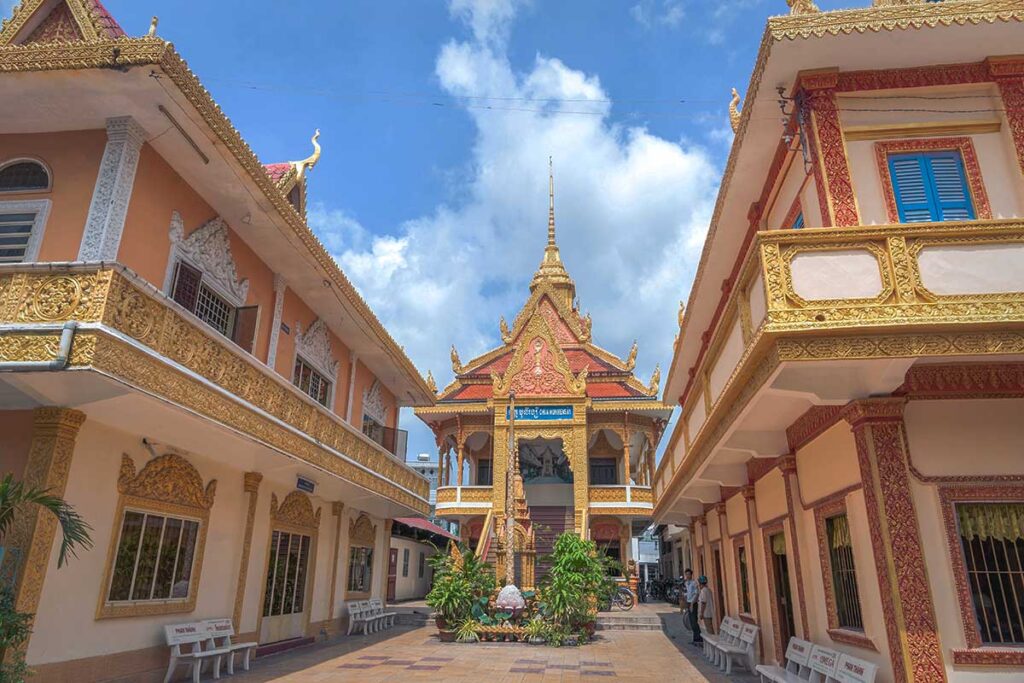What is Muniransay Khmer Buddhist Temple?
Muniransay Khmer Buddhist Temple is one of several Khmer pagodas you can find across the Mekong Delta. While not especially large or elaborate, it stands out in Can Tho because its design and traditions differ from the Vietnamese Mahayana pagodas most travelers encounter. The temple is part of the Khmer Theravada community, which maintains strong cultural and spiritual roots in southern Vietnam.
Khmer background in the Mekong Delta
The Khmer are an ethnic group native to the Mekong Delta, with cultural ties to Cambodia. Many communities still follow Theravada Buddhism, which explains why their temples look closer to Cambodian or Thai pagodas rather than Vietnamese ones. At Muniransay, you’ll see the familiar golden tones, steeply layered roofs, and decorative figures such as kinnari (mythical half-bird women), garuda-style birds, and protective guardians. These features make it feel more like an Angkor-inspired shrine than the typical red-and-grey tiled Vietnamese pagoda.
History & development
The temple was first established in 1948 as a simple bamboo structure, serving the Khmer community in central Can Tho. Over the years, it was rebuilt several times: the striking three-tower gate, modeled on Angkor Wat, was added in 1954, and the main hall was constructed in 1964. Since then, the site has undergone further renovations, giving it the more polished look visitors see today. Despite these changes, it has remained an important cultural and religious hub for Khmer Buddhists in the city.
Daily use & community role
Muniransay Temple is an active Theravada Buddhist site, where the focus is on worshipping Shakyamuni Buddha. It’s not only a place of prayer but also a community space. Monks live here, and the complex is said to host students from rural areas who use the temple’s dormitories while studying in Can Tho. Visitors sometimes meet monks who are open to conversation, though it’s best to approach respectfully. Because the temple sits right on busy Hoa Binh Boulevard, the atmosphere is less secluded than rural pagodas—you’ll still hear the hum of city traffic from outside the gates.
Highlights of visiting Muniransay Temple
1. Angkor-style entrance gate
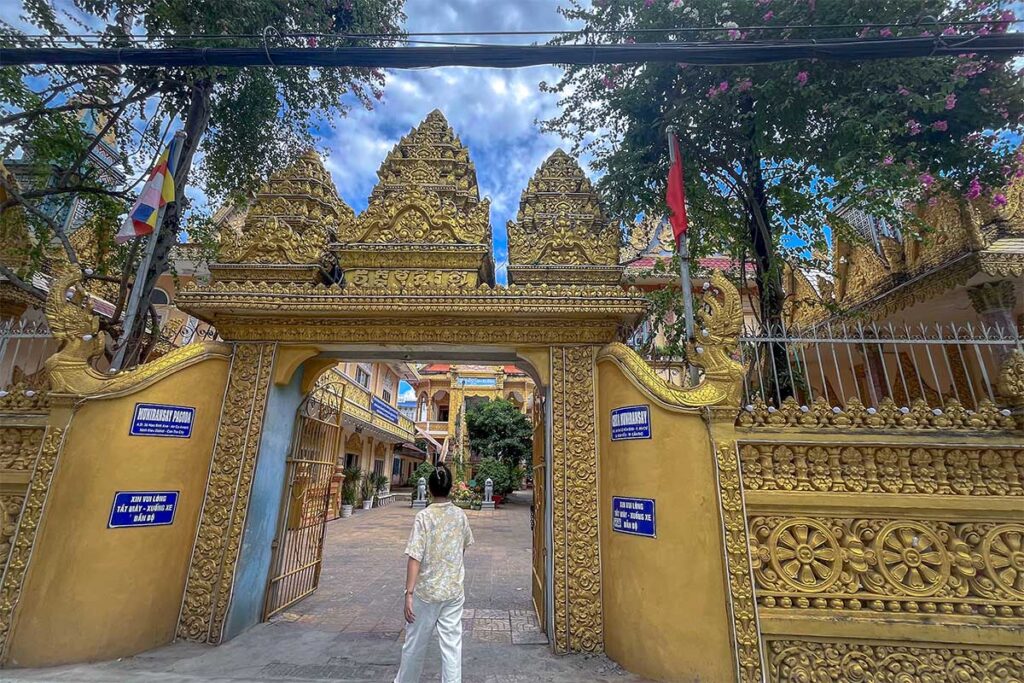
The first thing you’ll notice is the three-tower gate, designed after the Angkor Wat style. The towers symbolize the “Three Jewels” of Buddhism—Buddha, Dharma, and Sangha—and give the pagoda an immediately Cambodian feel. It’s one of the most photogenic spots at the temple, especially with the busy city street just outside contrasting with the ornate gate.
2. Stupa and courtyard details
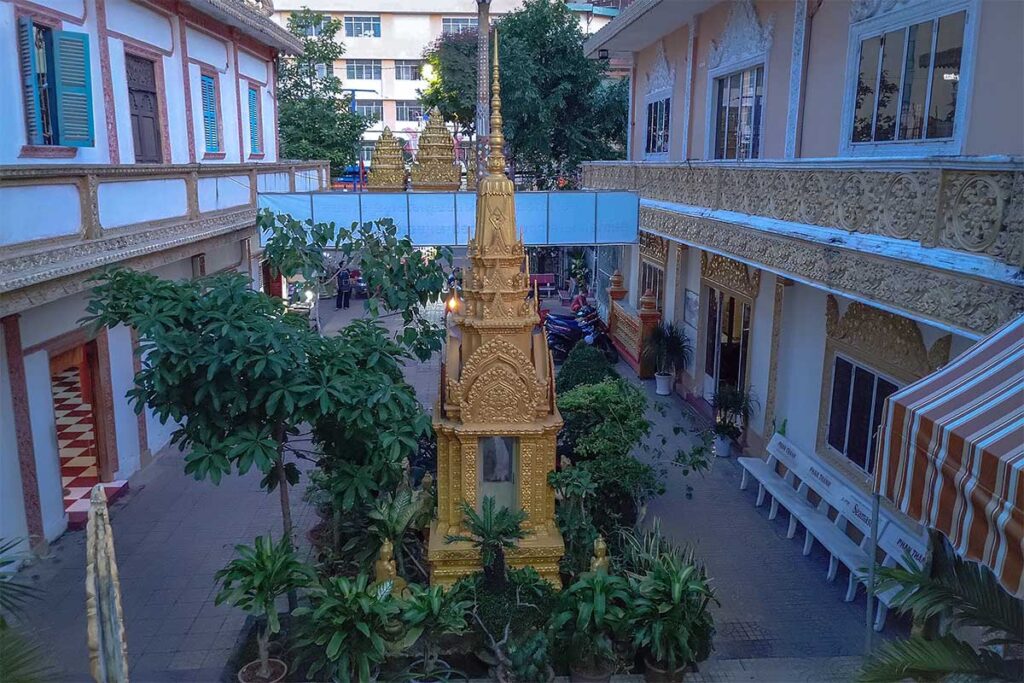
Inside the grounds stands a small stupa in front of the main hall, surrounded by decorative sculptures. Look for familiar Khmer motifs: kinnari figures (half-woman, half-bird), garuda-style birds (known locally as krud), fierce guardian giants (yeak), and cosmic creatures like reahu. These details are easy to overlook at first glance, but they add much of the character to the site. Late afternoon light filtering through the courtyard makes for the best photos, especially if you frame the stupa through the front gate.
3. Main hall (ubosot) architecture
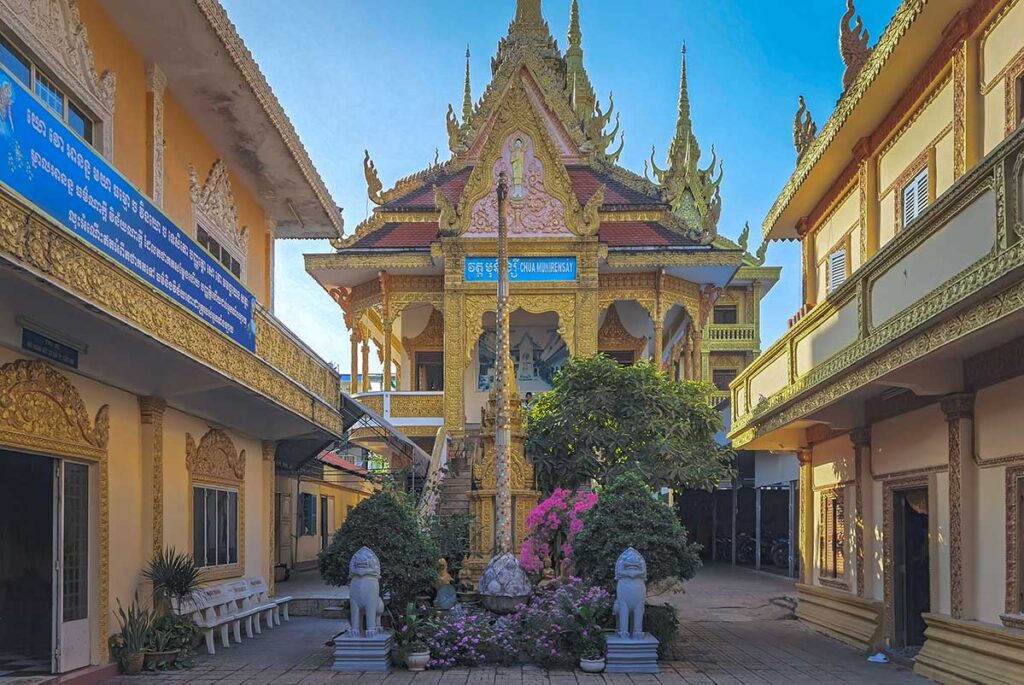
The main hall, or ubosot, sits about a meter above ground level and is reached by a short staircase. Its golden pediments, sculpted columns, and roof edges are typical of Khmer Theravada style.
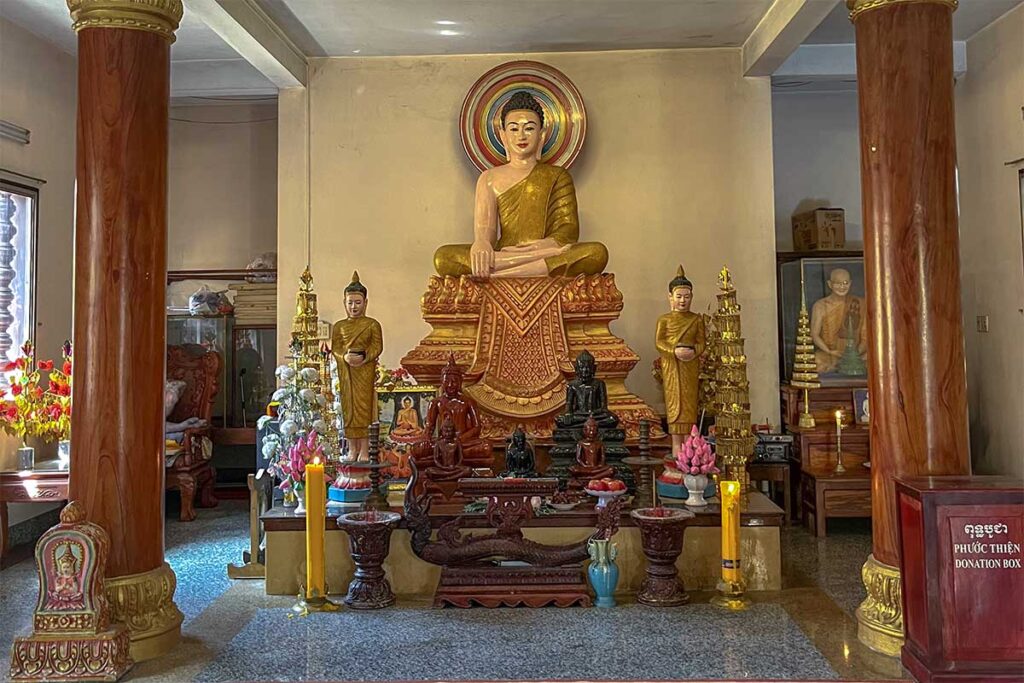
Inside, the focus is on a large image of Shakyamuni Buddha, rather than the multiple Buddhas and Bodhisattvas often found in Vietnamese Mahayana temples. Murals on the walls depict scenes from the Buddha’s life, giving the space a calm but solemn feel.
4. A short, calm pause in the city
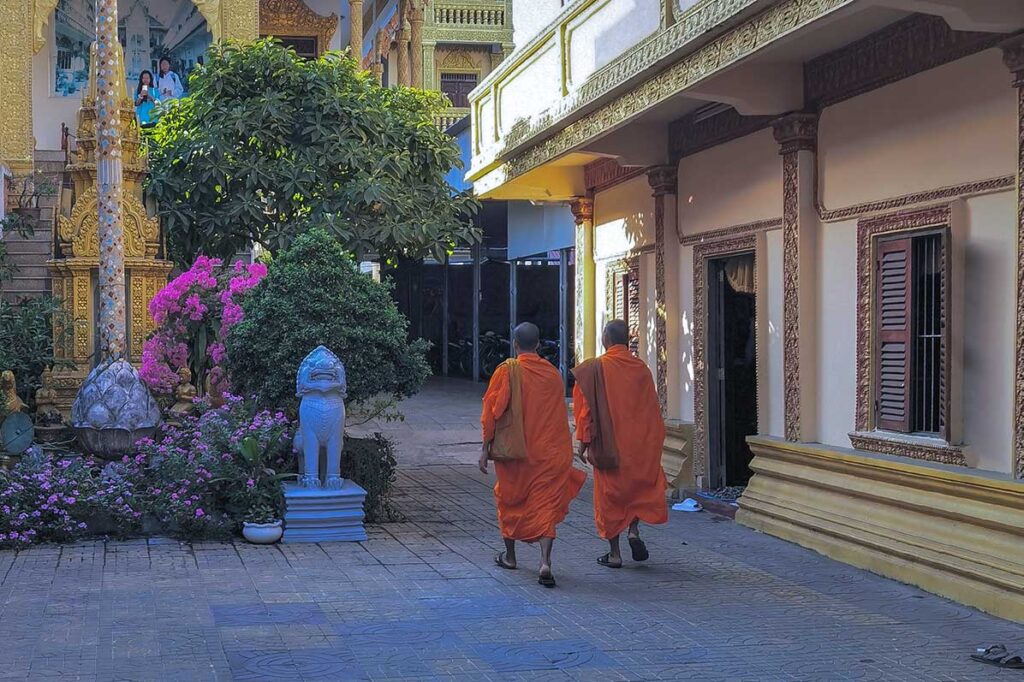
This is not a large temple complex—you can see everything in 15–30 minutes—but it offers a brief escape from Can Tho’s traffic. The grounds have a few shaded benches where you can sit quietly. Visitors sometimes meet monks who are happy to chat if they are free, adding a personal and welcoming touch to the experience.
Practical visiting information & tips
Opening hours & fees
Muniransay Khmer Buddhist Temple is generally open during the day, from around 08:00 to 18:00. There’s no formal ticket office and entrance is free, though donations are always welcome and appreciated.
Dress code & etiquette
Like other Buddhist temples in Vietnam, visitors are expected to dress modestly. Keep shoulders and knees covered, and remove your shoes before stepping into the main hall. Keep your voice low and avoid walking directly in front of people who are praying. If you’d like to take photos of monks or worshippers, always ask politely first.
Location & getting there
The temple is located at 36 Hoa Binh Boulevard, Ninh Kieu District, right in central Can Tho. From Ninh Kieu Wharf, it’s a short and easy walk, or just a few minutes by taxi or Grab. Because of its central location, it works well as a quick cultural stop while exploring the city on foot or by car.
Khmer festivals held here
Several Khmer Buddhist festivals are celebrated at Muniransay each year, following the lunar calendar:
- Chol Chnam Thmay (Khmer New Year) – around April.
- Ok Om Bok (Moon offering festival) – usually in November.
- Donta (Ancestor remembrance) – late August or September.
- Kathina (Robe-offering ceremony) – at the end of Buddhist Lent.
If you happen to visit during these times, expect a livelier atmosphere with music, drums, and dancing. It’s more crowded than on regular days but also more colorful and engaging.
How long to spend & best time of day
The temple is compact, so most visitors spend only 15–30 minutes here. Late afternoon is good for photography, when the golden decorations catch the warm light. Mornings are quieter if you prefer a calmer visit.
Nearby sights to combine
Because the pagoda is right in the city center, it’s easy to combine your visit with other attractions:
- Ninh Kieu Wharf – riverside promenade with boat piers and evening street food.
- Ong Pagoda – a vibrant Chinese-Vietnamese temple with giant incense coils.
- Can Tho Museum – useful for regional history and culture.
- Can Tho Central Market – for a look at daily local life.
Optional stops include the Military Zone 9 Museum and the many cafés scattered along Hoa Binh Boulevard and the riverside.
Handy tips
- Bring some small cash if you’d like to make a donation.
- Carry sun protection or a rain layer depending on the season.
- Remember that this is a city-center pagoda—you’ll hear traffic outside, so it’s not a serene countryside retreat.
Is Muniransay Khmer Buddhist Temple worth visiting?
Muniransay Khmer Buddhist Temple is best seen as a small, central stop rather than a major attraction. It’s worth dropping by if you’re already exploring downtown Can Tho, but not something to travel across the city for on its own.
The temple offers a quick glimpse of Khmer Theravada architecture in an otherwise busy Vietnamese city. The golden gate, stupa, and main hall are photogenic, though the setting on a main boulevard means it lacks the tranquility you might expect from a pagoda. Most visits take no more than 30 minutes.
If your travels take you further into the Mekong Delta—Soc Trang, Tra Vinh, or Bac Lieu—you’ll find larger and more impressive Khmer complexes. But if Can Tho is your main stop, Muniransay provides an easy introduction to Khmer Buddhist culture without leaving the city.
